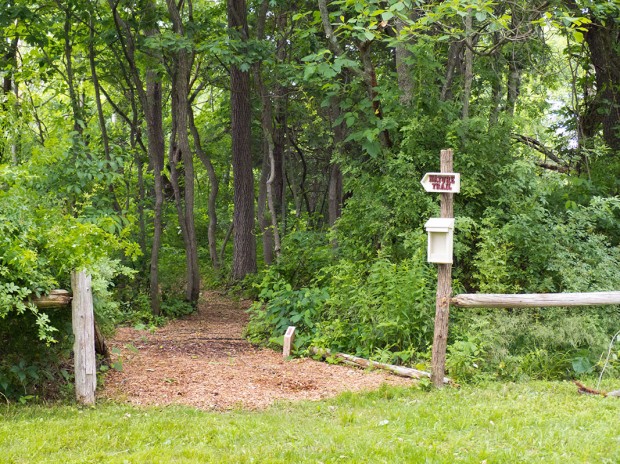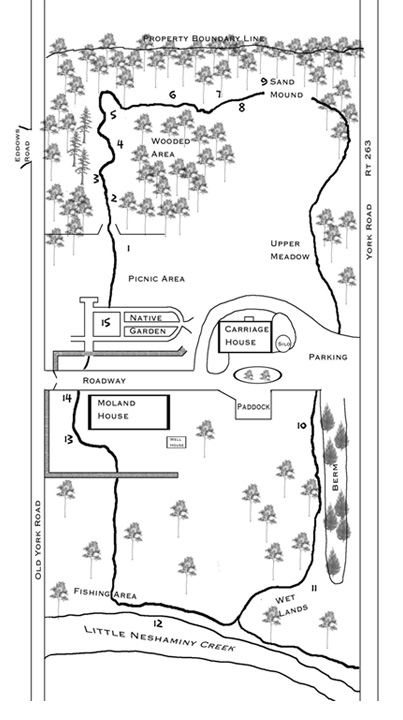The Moland House Historic Park Nature Trail is approximately a mile long. It can be walked as one complete trail or two short trails.
We suggest that you wear comfortable shoes.
Remember to avoid any poison ivy and check your clothes and hair for ticks after your walk.
All of the stops in this guide are clearly identified with numbers located on posts about one foot high.
The path itself is identified with yellow markers showing the silhouette of George Washington.
We would ask that you help us maintain the trail by disposing of any litter in the trash boxes that are located around the grounds.
For the safety of everyone involved, we ask that you not smoke while on the property and inform us if you see any problems along the trail including missing numbers, fallen trees, over-hanging branches, etc.
Stop 1: Woods: In Colonial times the area that you are entering probably was densely forested. Early settlers would have used the trees for construction, heat, food and medicine. Later wooded areas such as these would have been cleared for farming. With time, however, if undisturbed, the woodland can regenerate itself and become a dense forest.
Stop 2: Sassafras Tree: The Sassafras tree is a deciduous tree (meaning that it sheds its leaves for the winter) which is native to North America. It is commonly found growing in hardwood forests, abandoned fields, fence rows, and areas that have been disturbed in some way. It may grow to 80 feet in height, but normally is 20 to 35 feet. Interesting tidbit: Sassafras roots were used to make root beer and tea.
Stop 3: Cedar Tree: Cedar trees usually grow to a height of up to fifty feet, although some can reach 100+ feet. The natural oils in the wood are toxic to insects and fungus. Cedar trees were used by natives to make canoes and other boats. Cedar wood was also used to make weapons, boxes, bowls and baskets. The bark of the cedar tree was used to make blankets, capes and costumes. In modern times, cedar trees are used for making pencils & tools. 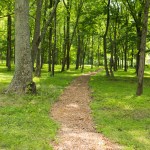
Stop 4: Dying Trees: Some (especially those that are standing) provide a home for cavity nesting birds and mammals whereas others (as they fall and decompose) return essential nutrients to the soil.
Stop 5: Ferns: Ferns have been with us for more than 300 million years. Ferns grow in many different habitats around the world. The ferns were at their height during the Carboniferous Period when they were the dominant part of vegetation. During that era some fern like groups evolved seeds (the seed ferns) making up perhaps half of the fern like foliage in the forests. Most of the ferns of that Period became extinct but some later evolved into our modern ferns. There are about 12,000 species in the world today.
Stop 6: Black Walnut Tree: The black walnut tree was used during colonial times to make cabinets, furniture and gun stocks. The tree produces a nut that is rich in fiber, B vitamins, magnesium, and antioxidants such as Vitamin E.
Stop 7: Wild Grape Vines: Grape vines are perennial, woody vines with dark gray-brown bark that is sloughed off in long, narrow strips. Grape vines cling by means of forking tendrils: small, narrow branches specialized for grasping, which coil themselves around tree limbs and other such supports. Unfortunately, grapevines can be a problem because they damage trees by breaking tops and limbs, and twisting, bending, and often breaking tree boles. In addition, they can cause trees to be uprooted and killed. On the other hand, grapevines produce food and cover for many species of wildlife.
Stop 8: Nurse log: A fallen tree can help with the regeneration of the forest. As the log rots, former branches can take root and develop into new trees. Note the tree that is growing from the fallen, decaying log.
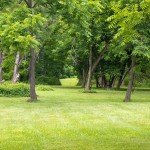 Stop 9: Sand Mound: In the event of poorly drained soil, one that has a high clay content or located in a low-lying area, a standard drainage field will not work very well. Since, wastewater cannot drain into soil that is saturated, a sand mound sewage disposal system is frequently used. A perforated pipeline in the pile of sand allows the effluent to drain. As is evident with the sand mound in front of you, sand mounds are usually covered with soil and grass.
Stop 9: Sand Mound: In the event of poorly drained soil, one that has a high clay content or located in a low-lying area, a standard drainage field will not work very well. Since, wastewater cannot drain into soil that is saturated, a sand mound sewage disposal system is frequently used. A perforated pipeline in the pile of sand allows the effluent to drain. As is evident with the sand mound in front of you, sand mounds are usually covered with soil and grass.
Stop 10: Berm: A berm is a mound of earth built to serve a specific purpose such as bolstering defense, providing privacy or adding variation to a landscape. Unlike a fence, berms have a natural look and feel to them thus enabling them to help insulate a home from noise and wind without being obtrusive. The berm itself can be landscaped with grasses and trees to give it a more natural look and feel.
Stop 11: Wetlands: The wetlands provide a rich habitat for both animals and birds. Wetlands are one of nature’s ways of filtering and storing ground water. Although the area, on occasion, may appear dry, with rain the wetlands usually will return to their original purpose.
Stop 12: Creek: This stream, which is identified as the Little Neshaminy, eventually flows into the larger Neshaminy Creek and finally winds its way to the Delaware River. It served as a way to get from one area to another and as an essential energy resource for the grinding mills that frequently dotted its banks.
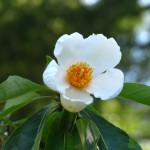 Stop 13: Franklinia Tree: In 1765, John Bartram and his son William, came upon a special tree while walking in the Altamaha river basin in Georgia. A few years later John returned, gathered some seeds and brought them to his garden in Philadelphia. He named it the Franklinia alatamaha (Commonly called the Franklin Tree) in honor of his great friend, Benjamin Franklin. The tree was never seen in the wild after 1803. Today, all of the Franklinia trees are descended from those propagated and distributed by the Bartrams. Historians have credited the Bartrams with saving the tree from extinction.
Stop 13: Franklinia Tree: In 1765, John Bartram and his son William, came upon a special tree while walking in the Altamaha river basin in Georgia. A few years later John returned, gathered some seeds and brought them to his garden in Philadelphia. He named it the Franklinia alatamaha (Commonly called the Franklin Tree) in honor of his great friend, Benjamin Franklin. The tree was never seen in the wild after 1803. Today, all of the Franklinia trees are descended from those propagated and distributed by the Bartrams. Historians have credited the Bartrams with saving the tree from extinction.
Stop 14: Moland House: For 13 days in August 1777, George Washington and his troops encamped both in and around the Moland House. It was also here that the Marquis de Lafayette and Count Casamir Pulaski were introduced to the colonial troops. Additional information about this encampment can be found on the signage located in the entrance area across from the Carriage House. Scheduled tours are available the second Sunday of each month or by special appointment.
Stop 15: Decorate Colonial-Style Garden: An ornamental garden in Colonial style.

